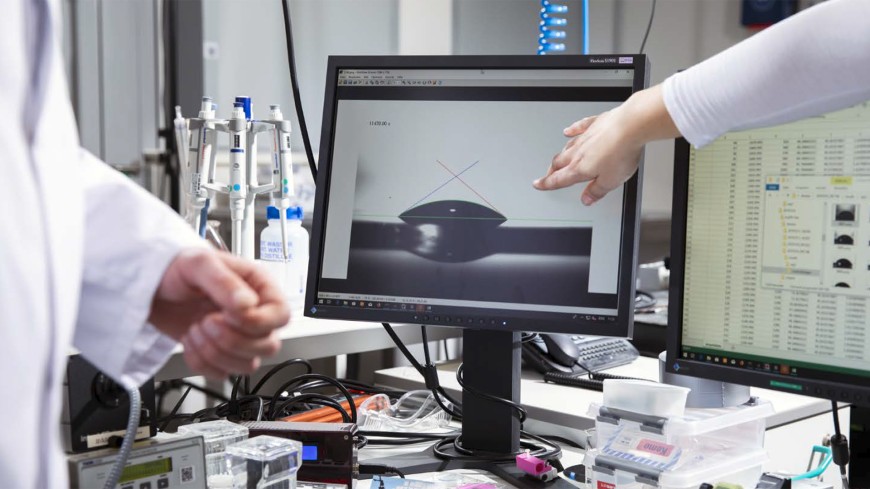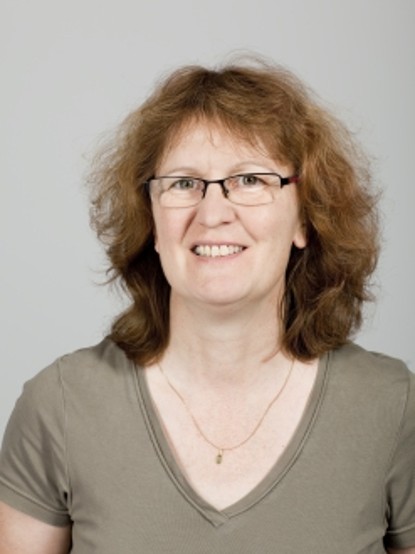Focus on wetting and transport phenomena to be continued
The DFG has approved four more years of funding for the Collaborative Research Centre 1194
2020/05/29
The German Research Foundation (DFG) has approved a second funding period (2020–2024) for the Collaborative Research Centre “Interaction between Transport and Wetting Processes” (CRC 1194).

The research of the CRC is relevant for modern printing and coating technologies, efficient, phase-change heat transfer processes or medical and environmental technology, for instance. What exactly happens when structured surfaces, i.a., during printing or in a medical quick test interact with complex fluids? How do wetting and de-wetting processes depend on local momentum, heat and mass transfer? The underlying mechanisms of the interaction between these processes have to a large extent not been understood to date. Although the physical phenomena take place only in a range of nanometres or micrometres, they often determine the efficiency of the overall process and the resulting product quality.
New momentum in the second funding period
During the second funding period (July 1, 2020 — June 30, 2024) the CRC 1194 comprises nine experimental subprojects with a clear focus on phenomenological fundamentals, six subprojects in the area modelling and simulation and seven subprojects that deal with new or improved applications . In the second funding period, the CRC is supported by additional project coordinators (A01 : Prof. Dr.-Ing. Jeanette Hussong, A09 : Prof. Dr. Regine von Klitzing, C06 : Prof. Dr-Ing. Peter Pelz) and could recruit two CRC young researchers as project coordinators (B02 : Dr.-Ing. Dirk Gründing, B06 : Dr.-Ing. Florian Kummer). There are four new subprojects, which are described in detail below.
Subproject A09
: “Nanoscale investigation of wetting and de-wetting during imbibtion and nucleation” (project coordination: Prof. Dr. Regine von Klitzing, Department of Physics)
This new experimental subproject is dedicated to nanoscale investigations of wetting and dewetting during imbibition and nucleation. It should allow a deeper understanding of surface effects on the deformation of the contact line on a nanoscopic length scale. A scanning force microscope is used to scan the contact line with a resolution of 10-30 nm. Differences between nanoscopically and macroscopically measured contact angles are analyzed. In addition to simple fluids and surfaces, mixtures and mesoporous as well as swellable surfaces are used. A nanoscale body immersed into the air/water will be used to study the local distribution of substances. This generic configuration will be compared directly with simulations.
Subproject B07
: “Scale bridging simulation of dynamic wetting based on the phase field method” (project coordination: Dr.-Ing. Holger Marschall, Department of Mathematics)
This new project aims at the fundamental understanding of local transport processes at the contact line in multiscale, dynamic wetting processes on complex substrates. A proprietary CFD-solver based on the diffuse-interface phase field method and developed in OpenFOAM
will be used. The method enables the description of imbibition and penetration processes in porous/structured substrates, especially during capillarity dominated wetting. Focus lies on the exact detection of local heterogeneities (pore size distribution, roughness, functionalization) as well as on a scale bridging methodology, to be realized by combining modern HPC techniques, DG methods and the hybrid atomistic-continuum method.
Subproject C06
: “Contact line dynamics and diffusion-driven nucleation during cavitation” (project coordination: Prof. Dr.-Ing. Peter Pelz, Department of Mechanical Engineering)
This new application-oriented project deals with cavitation – a highly relevant phenomenon in hydraulic machines as it can lead to wear, noise and loss of function. The formation and dynamics of a cavitation bubble depend on both the diffusion of inert gases from the supersaturated liquid and the evaporation. These mass transport and phase change processes are strongly influenced by the wetting properties and vice versa. In a test bench, nucleation and cavitation are recorded with high resolution including the contact line region. Analytical models are derived and validation and comparison data are made available to other subprojects.
Teilprojekt C07
: “Measurement technique and instrument for determining the lateral adhesion of drops” (project coordination: Prof. Dr. Hans-Jürgen Butt, Max Planck Institute for Polymer Research Mainz)
This new project is the result of findings from C03
in the first funding period. There, a method was developed with which the force required to move a drop over a surface can be measured directly. With this method inhomogeneities on surfaces can be characterized and the dynamic contact angles can be measured. In C07, the method is to be further developed and established as a multifunctional measuring device. In addition, scientific questions are to be clarified regarding the role of defects, impurities or an electric charge in contact angle hysteresis.
The subprojects B05 “Molecular modelling of complex fluids in proximity of the three-phase contact line” and C05 “Amplfication of the electro-osmotic flow on superhydrophobic surfaces” expire at the end of the first funding period.
About the CRC 1194
The CRC 1194 involves researchers from the Technical University of Darmstadt, the Max Planck Institute for Polymer Research Mainz and the Leibniz Institute of Polymer Research Dresden. Speaker of the CRC 1194 is Prof. Dr.-Ing. Peter Stephan (Department of Mechanical Engineering, TU Darmstadt), deputy speaker is Prof. Dr. Dieter Bothe (Department of Mathematics, TU Darmstadt).

